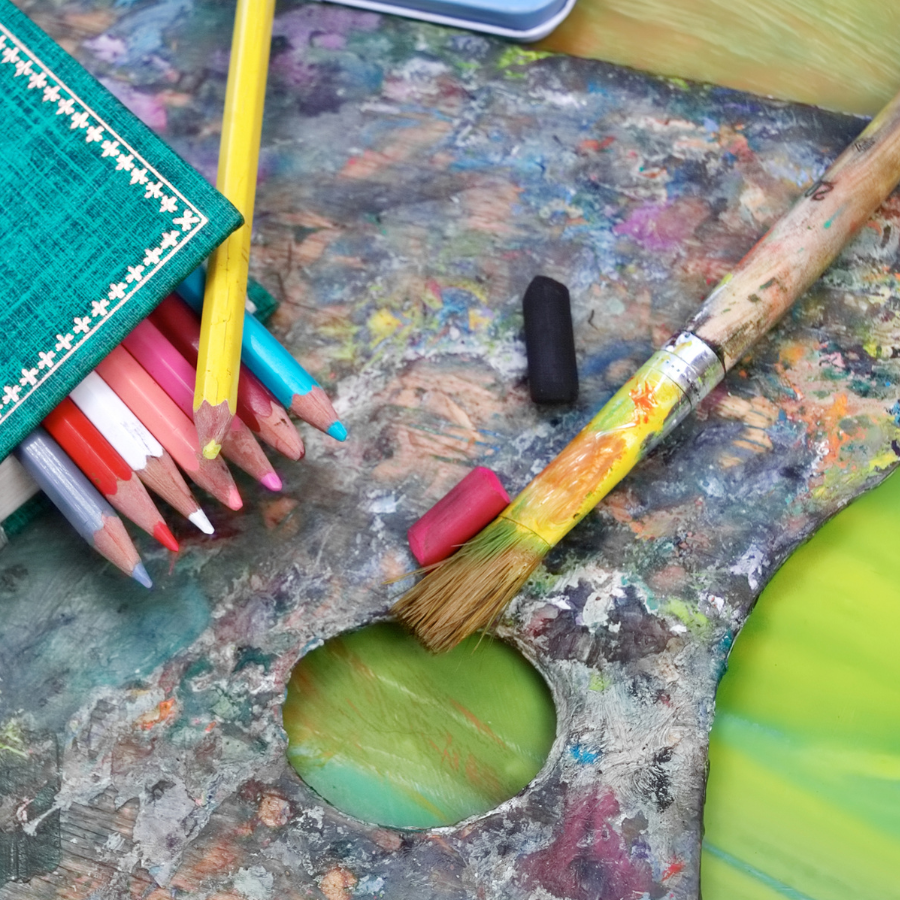visual arts overview
The visual arts department has a long established position at The Park School. It is a program of study that, by its very nature, is reflective of the principles of the School. Learning takes place in the process of making art as much as it does in all the other areas of education. To make art is a challenging goal, and the objective is to learn through the experience of making and creating.
In the visual arts program, students are encouraged to express their ideas both independently and collectively. They are guided through controlled exposure to a broad range of artistic styles and mediums. Art history is presented in terms of exposure to different artists and their ideas. Cultural, social, philosophical, and political ideas are discussed and encouraged.
We endeavor to reflect on the academic material covered in students’ core subject areas (such as science, math, social studies, etc.) to promote art education as a holistic experience rather than a separate area of study. Art is an area of study that requires a balance between the rational, analytical mind and the perceptive mind. We challenge the students to make statements that reflect their interests.
We want them to enjoy the process of exploring, to exhibit curiosity, and to discover those personal strengths that will make them more effective communicators. Students in the upper grades are evaluated by a variety of methods, including class participation and consistent effort, group critique, sketchbook/journal, self-assessment/response sheets, project evaluation, and final project/exams. Self-assessment sheets encourage students to fully—and thoughtfully—critique their work in written form. Students do not grade themselves with these sheets, but they make statements regarding the effectiveness of their work and the learning outcomes they have experienced.
We often have upper school students with specialized interests not covered by the standard curriculum. In order to encourage those interests, we have designed a program of contractual advanced study to meet the special needs of individual students. The class structure of the advanced study periods resembles a small community of artists pursuing individual interests, thus providing a very rich experience for all students involved.
courses offered
Studio Art I
This is a half-year foundation course designed to familiarize students with the basic elements of art: line, form, space, value, texture, and the principles of design: balance, rhythm, variety, unity and perspective. The goal of this course is to enable the students to incorporate those elements of art and principles of design into a working composition or statement. We will combine an understanding of Art History with many projects in this course. The Art History will provide an understanding of the ideas behind the work in relation to its time and allow for individual interpretation by the students.
AP Studio Art
The AP art program is designed for students who feel ready to accept the challenges and rigorous requirements of a college level art course. Students that are considering a concentration in art for college may elect to take this course as a structured resource for developing their individual portfolio. Students must select from three specific AP course descriptions, and must meet exacting requirements to submit work for formal evaluation. This is a rigorous course. Students who elect to take this course must be prepared to devote a significant amount of time to the production of artwork. In excess of thirty artworks must be completed for a Drawing or Two-Dimensional Design portfolio review. A minimum of twenty-six artworks must be generated for the 3-D Design portfolio.
Art In Motion!
This class will investigate the many ways movement can be presented through art. From how to show motion on canvas, to breaking free from the page and creating movement with sculptural forms, to finally ending with moving pictures. Students will learn about artists like Alexander Calder, who mastered suspended forms; Victor Vasarely, who showed motion through color; and others. Projects will include but are not limited to: hanging mobiles, kinetic sculptures, comic books, and claymation/stop motion film.
The Clay & Pottery Challenge
This class will focus on the clay processes of pottery, handbuilding, sculpture, and clay. Each week, students will be introduced to a short activity and technique to try with clay. That will lead to a bigger challenge, that involves the same techniques, a general project idea, and an individual twist. This class is for beginners, or those who are ready for a great clay challenge!
The Culture of Art
Cultural art is a tool that helps develop thoughts, reflect and represent lives and communities in different ways. Cultural arts help to explain the world in which we live, through an exploration of creativity. As a class we will explore different cultures and experiment with materials and ideas as those different cultures did. Projects may include drawing and painting, working with fiber and material, clay, crafts, and more.
Earth Art and Design in Nature
This class will revolve around the outdoors and the Park Campus. Students interested will get to know the ins and outs of the campus, design spaces to incorporate art, design a natural “playground”, and more. Students will come up with ideas, collaborate with classmates, and bring their ideas to life. The class will involve physically building structures, using power tools, and a little muscle! Limited to 10 students.
People, Places & Things
This is a drawing and painting course that will review and introduce new techniques such as perspective drawing, gesture and contour drawing, shading and blending, drawing from observation, color mixing and application. The class will look at a variety of artists and art styles, learn why they did what they did, and to inspire ideas of our own.
Repurposed Art
Today's society generates an enormous amount of trash. Glass bottles, plastic bags and other waste that would end up filling landfills or floating in the sea, now can become a form of sustainable art! Giving “waste” a second chance with upcycling has led to an artistic movement known as recycled art. Going beyond just recycling, this type of art transforms waste such as paper, cardboard, wood, glass, plastics, metals and rubber into new amazing sculptures, collages and creations.
A Revolution of Art
This class will cover how art has rebelled over the years. Starting back with the invention of the camera in the 1800s allowing artists to break free from the societal norms of the times, giving art a chance to take on a life of its own. A Revolution of Art will go through different art movements throughout the years starting in the late 1800s to modern day. For each art movement, students will learn and discuss a new style and techniques with the creation of a project using a variety of mixed media. From creating 3D Cubism forms to giant splatter paintings of Abstract Expressionist movement students will see and understand first-hand how and why art grew and changed over the years.
Urban Art
This class will cover graffiti art, street art, public art and installation art, and the subject matters connected with contemporary urban culture, political issues, and creating visual statements. Looking at artwork and discussing artists starting with Keith Haring, Jean-Michel Basquiat, Banksy, and Adam Neate to present day and local artists. Being inspired by the world around them, they will come up with ideas and messages, and create visual representations, using prints, paint, stencils, spray paint, and mixed media.
Women of Art
Many great female artists tend to be forgotten in art history. Those who have been neglected and marginalized for years or even centuries. Caterina van Hemessen of the 1500s was the first painter to create a self-portrait depicting an artist at their easel. Hilma Klint created abstract art that even preceded those of Kandinsky. This class will go through several decades of female artists, past and present, creating art that builds on and incorporates in the many styles of these artists. This class will have a heavier focus on painting, but still use a variety of mediums, including collage, sculpture and patchwork.



